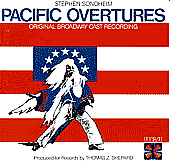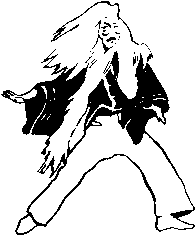PACIFIC OVERTURES

a musical play in two acts. Book by John Weidman; additional material by Hugh Wheeler.
Music and lyrics by Stephen Sondheim.
First performance staged and produced by Harold Prince at the Winter Garden, New York, 11 January 1976 with Mako (Reciter), Isao Sato (Kayama), Sab Shimono (Manjiro), Yuki Shimoda (Lord Abe), Haruki Fujimoto (Perry) and Alvin Ing (Shogun's Mother).
Produced at the Forum, Wythenshawe, Manchester, England, 30 April 1986 with Simon Clark, Paul Hegarty, Paul Baden, Christopher Brown, Mitch Sebastian and Thom Booker.
Produced by the English National Opera at the London Coliseum, 10 September 1987 with Richard Angas, Malcolm Rivers, Christopher Booth-Jones, John Kitchiner, Graham Fletcher and Simon Masterton-Smith.
Synopsis
Act I
Conceived as a sort of Japanese playwright's version of an American
musical about American influences on Japan, Pacific Overtures begins
its journey to the present day in July 1853. Since the foreigners were
driven from the island empire, explains the Reciter, there has been
nothing to threaten the changeless cycle of their days. Elsewhere,
wars are fought and machines are rumbling but in Nippon they plant
rice, exchange bows and enjoy in peace and serenity.
But President Fillmore, determined to open up trade with Japan, has
sent Commodore Perry across the Pacific, and. to the consternation
of Lord Abe and the Shogun's other Councillors, US warships have been
sighted at Okinawa. Kayama is appointed Prefect of the Police at Uraga
to drive the Americans away - news which leaves Tamate, his wife, grief-stricken.
As he leaves, she expresses her feelings in dance as two Observers
describe the scene and reveal her thoughts in "There Is No Other Way". As a Fisherman,
Merchant and other locals relate the sight of the "Four Black Dragons"
roaring through the sea, an extravagant Oriental caricature of the USS
Powhatan pulls into harbour: Commodore Perry announces that he must meet
the Shogun within six days or else he will shell the city. Faced with
this ultimatum the Shogun takes to his bed. Exasperated by his indecision,
his Mother with elaborate courtesy, poisons him with "Chrysanthemum
Tea."
With the Shogun dead, Kayama devises a plan by which the Americans,
thanks to a covering of tatami mats and a raised Treaty House, can
be received without having, technically, to set foot on Japanese soil.
He and his aide the fisherman Manjiro set off for Uraga, forging a
band of friendship through the exchange of "Poems". Already, though, events are moving beyond
the control of the old order: the two men pass a Madam instructing her
inexperienced Girls in the art of seduction as they prepare to "Welcome
to Kanagawa" the foreign devils.
 Commodore Perry and his men come ashore and, on their "March to the Treaty
House", demonstrate their goodwill by offering such gifts as two bags
of Irish potatoes and a copy of Owen's "Geology of Minnesota". The negotiations
themselves are seen through the memory of an old man and his younger self
-"Someone In a Tree", watching silently as history changes course. Initially,
it seems as if Kayama has won: the Americans depart in peace. But then
the barbarian figure of Commodore Perry leaps out to perform a traditional
Kabuki "Lion Dance", which ends as a strutting, triumphalist,
all-American cakewalk.
Commodore Perry and his men come ashore and, on their "March to the Treaty
House", demonstrate their goodwill by offering such gifts as two bags
of Irish potatoes and a copy of Owen's "Geology of Minnesota". The negotiations
themselves are seen through the memory of an old man and his younger self
-"Someone In a Tree", watching silently as history changes course. Initially,
it seems as if Kayama has won: the Americans depart in peace. But then
the barbarian figure of Commodore Perry leaps out to perform a traditional
Kabuki "Lion Dance", which ends as a strutting, triumphalist,
all-American cakewalk.
Act II
To the surprise of Lord Abe, now the new Shogun, and Kayama,
now Governor of Uraga, the Americans return to bid the Japanese court
"Please Hello" and to request formal trading arrangements. They are followed
by a Gilbertian British Admiral, a clog-dancing Dutch Admiral, a gloomy
Russian and a dandified Frenchman all vying for access to Japan's markets.
Manjiro continues to dress with painstaking slowness into ceremonial robes
for the tea ritual, but Kayama is adopting the manners and dress of the
newcomers, proudly displaying his new pocket watch, cutaway coat and "A
Bowler Hat". But there are other less pleasant changes prompted by westernisation.
Three British Sailors mistake a "Pretty Lady" for a geisha,
the girl cries for help and a Swordsman kills the fleeing Tars. Reporting
on the situation to the Shogun, Kayama himself is killed by a cloaked
assassin - his former friend, the fisherman Manjiro.
In the ensuing turmoil the puppet Emperor seizes the real power from
the Shogun and vows that Japan will modernise itself. As the country
moves from one innovation to the "Next!", the Imperial robes are removed layer
by layer to show the Reciter in T-shirt and black trousers. Contemporary
Japan - the world of Toyota and Seiko, air pollution and contaminated
beaches -assembles itself around him. "There was a time when foreigners
were not welcome here. But that was long ago," he says. "Welcome
to Japan."
Musical Numbers
Act One
- Prologue — Orchestra
- The Advantages of Floating in the Middle of the Sea — Reciter and Company
- There Is No Other Way — Tamate, Observers
- Four Black Dragons — Fisherman, Thief, Reciter, Townspeople
- Chrysanthemum Tea — Shogun, Shogun's Mother, Shogun's Wife, Soothsayer, Priests, Shogun's Companion, Physician, Sumo Wrestlers
- Poems — Kayama, Manjiro
- Welcome to Kanagawa — Madam and Girls
- March to the Treaty House — Orchestra
- Someone in a Tree — Old Man, Reciter, Boy, Warrior
- Lion Dance — Commodore Perry
Act Two
- Please Hello — Abe, Reciter, American, British, Dutch, Russian and French Admirals)
- A Bowler Hat — Kayama
- Pretty Lady — Three British Sailors
- Next — Reciter and Company
Characters:
(Subject to the authors' caution that Pacific Overtures is an attempt to tell a story with no characters)
- RECITER - A traditional figure from Japanese theatre who guides us through the nation's developments from "Nippon, the floating kingdom" to today's business powerhouse. From time to time, he throws off his reciter's robes and plays other parts, such as the Shogun ruling lord of all Japan; and later Emperor Meiji.
- KAYAMA YESAEMON - A minor samurai chosen by the Shogun to repulse Commodore Perry and the unwanted foreigners. As the play progresses, he rejects almost all native customs and becomes more and more westernised.
- JOHN MANJIRO - A commoner, a fisherman who has been to America, and, in dramatic contrast to Kayama, immerses himself in the values of old isolationist Japan even as western influences are swamping the nation.
- LORD ABE - First Councillor to the Shogun and the most illustrious Japanese dignitary to participate in the negotiations with Commodore Perry.
- MATTHEW GALBRAITH PERRY - A Commodore in the US Navy whose landing at Kanagawa on 14 July 1853 ends Japan's historic separation from the modern world.
- THE SHOGUN'S MOTHER - Just as the Shogun had his own father strangled, so his mother, impatient at his indecision towards the Americans, eventually moves against him. Like the other female parts in the play, she is played by a man.
- TAMATE - Wife to Kayama
- PHYSICIAN - Member of the Shogun's Court
2nd & 3rd Councillors To The Shogun, 2 Observers, 1st &; 2nd Officers of the USS Powhatan, Soothsayer, Companion, Wife, Priests, Madam &; 4 Geishas, Old Man, Boy, An Admiral apiece from the American, British, Dutch, Russian &; French Navies, 2 Lords of the South, 3 British Sailors, 4 Assassins, A Fisherman, A Merchant & His Family, A Thief, A Warrior, The Emperor's Court, A Storyteller, A Fencing Master & His Daughter, Sumo Wrestlers, Palanquin Bearers, Samurai, Townspeople, Rickshaw Pullers, Contemporary Japanese Men & Women & American Sailors
Orchestration Details
- Reed I - Piccolo, Flute, Alto Flute, Soprano Recorder
- Reed II - Flute, Clarinet, Eb Clarinet
- Reed III - Flute, Clarinet, Bass Clarinet
- Reed IV - Bassoon
- 2 Horns
- 2 Trumpets
- Trombone
- Harp
- Electronic Piano db. Celesta
- Shamisen
- Percussion
- Strings
Discography
- RCA VICTOR RD 84407 - Original Cast
- RCA VICTOR RD 87995 - English National Opera Cast (USA only)
- TER CDTER 1151 - English National Opera Cast